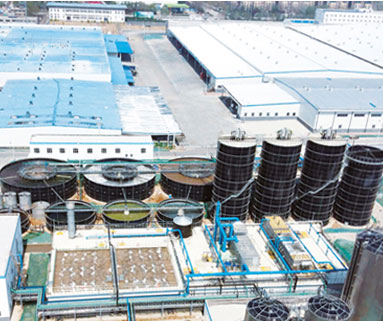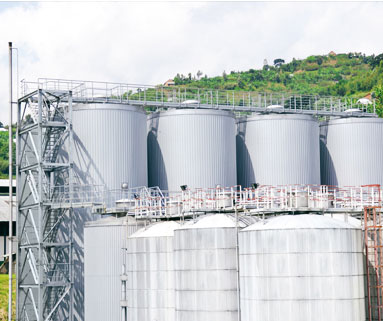
The IC reactor is the expanded granular sludge bed reactor. It is a third-generation anaerobic bioreactor developed on the basis of the UASB reactor. It recirculates the effluent water and greatly increases the rising flow rate of sewage. The granular sludge is always in an expanded state, which strengthens the contact and mass transfer between sewage and microorganisms, and obtains a higher removal efficiency. The height of the reactor is as high as 16-25 meters.
The IC reactor is divided into 5 zones from bottom to top: mixing zone, first anaerobic zone, second anaerobic zone, precipitation zone and gas-liquid separation zone.
The inlet water at the bottom of the reactor, granular sludge and the mud-water mixture returning from the gas-liquid separation zone are effectively mixed in this zone.
The mud-water mixture formed in the mixing zone enters the zone, and most of the organic matter is converted into biogas under the action of high-concentration sludge. The upflow of the mixed liquid and the severe disturbance of the biogas make the sludge in the reaction zone expand and fluidize, which strengthens the surface contact of the sludge and the sludge maintains high activity. With the increase of biogas production, a part of the mud-water mixture is lifted by the biogas to the gas-liquid separation zone at the top.
The biogas in the lifted mixture is separated from the muddy water and exported to the treatment system. The muddy water mixture returns to the lowermost mixing zone along the return pipe, and is fully mixed with the sludge and influent at the bottom of the reactor to achieve the Internal circulation.
Except for a part of the wastewater treated by the first anaerobic zone, which is lifted by biogas, the rest will enter the second anaerobic zone through a three-phase separator. The concentration of sludge in this area is low, and most of the organic matter in the wastewater has been degraded in the first anaerobic zone, so the amount of biogas produced is small. The biogas is introduced into the gas-liquid separation zone through the biogas pipe, which has little disturbance to the second anaerobic zone, which provides favorable conditions for the retention of sludge.
The sludge-water mixture in the second anaerobic zone undergoes solid-liquid separation in the sedimentation zone, the supernatant is discharged from the outlet pipe, and the precipitated granular sludge returns to the sludge bed in the second anaerobic zone.
Highly settled sludge particles
The reactor has a high volume load
The hydraulic residence time of the reactor was correspondingly shorter
It integrates biological reaction and precipitation separation, compact structure
No hysteresis setting filler, save the cost, increase the volume utilization ratio
No need to set up a stirring device and the updraft produced by the updraft and methane plays a starring role
The structure is simple and the operation is convenient

Dairy wastewater

Pharmaceutical wastewater

Brewing wastewater